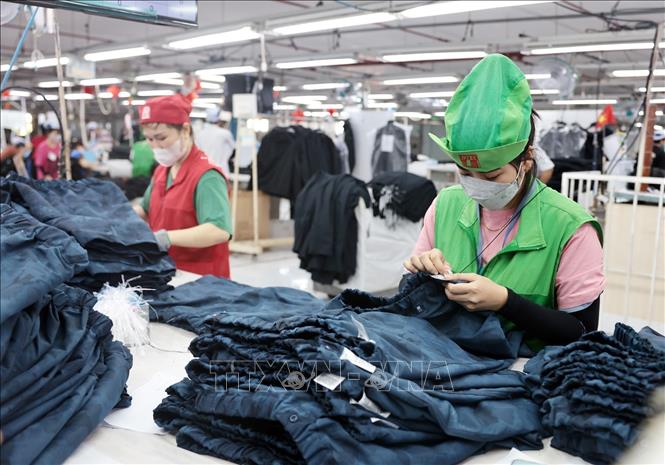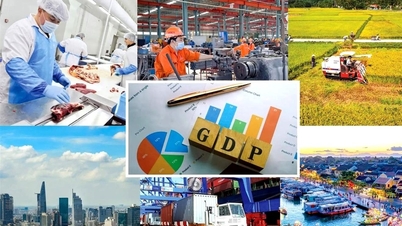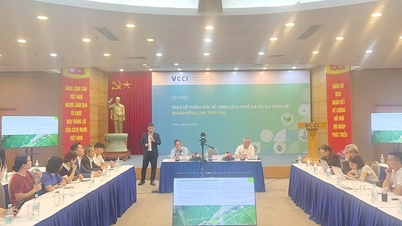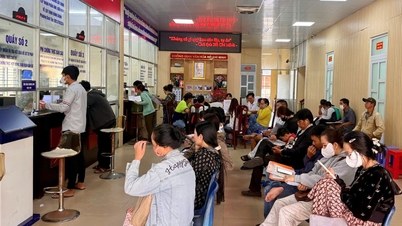
According to data released by the General Statistics Office and cited by many international news agencies, this is the highest increase since 2011, reflecting the strong adaptability of the economy in a volatile global context.
Notably, this increase occurred even when the US officially imposed a 20% tax on most imported goods from Vietnam, starting from August 7. Reuters news agency cited that Vietnam's total import-export turnover by the end of September 2025 reached more than 680 billion USD, with a trade surplus of 16.8 billion USD. Inflation in September 2025 remained at 3.38%, lower than the target of 4.5-5% set by the Government , while industrial production in the third quarter of 2025 increased by 9.1%, and foreign direct investment (FDI) disbursed in the first 9 months of the year reached the highest level in 5 years.
Vietnam's exports in September 2025 fell 1.7% from August 2025, marking the second consecutive month of decline, mainly due to the impact of new tariffs from the US, Reuters reported. However, overall exports to the US in the first nine months of this year still increased 38% compared to the same period in 2024, thanks to the growth of coffee, chemicals and electronic components, offsetting the decline in the textile and footwear industry.
In the third quarter of 2025, total export turnover reached 128.57 billion USD, up 18.4% over the same period last year, while imports reached 119.66 billion USD, up 20.2%, helping Vietnam maintain a trade surplus of 8.91 billion USD.
International observers say this result reflects the flexibility of Vietnam's manufacturing industry, especially in the electronics, chemicals and renewable energy sectors – industries that are benefiting from the trend of diversifying global supply chains and preferential bilateral tax policies.
According to analysis from the website ainvest.com (USA), Vietnam has maintained a good recovery momentum thanks to three main driving forces, including: FDI capital continues to increase, international tourism recovers strongly and domestic consumption and credit growth is positive. In addition, inflation continues to be controlled at a low level, helping consumers have more room to spend, contributing to stabilizing domestic aggregate demand.
Ainvest.com asserts that, in the context of traditional exports being affected by US tariffs, Vietnam is emerging as a new renewable energy hub in Asia. The manufacturing PMI index in September 2025 reached 50.4 points, reflecting the "cautiously optimistic" sentiment of businesses. The clean energy industry, especially solar and wind power, is becoming a bright spot. Although the US-based Institute for Energy Economics and Financial Analysis (IEEFA) warns of risks from anti-dumping tariffs and competitive auction mechanisms, investors still assess that Vietnam has a clear comparative advantage thanks to abundant resources, competitive costs and a stable investment environment.
However, some prestigious international organizations note that Vietnam is still facing some risks in the remaining months of the year. According to the International Monetary Fund (IMF), the impact of US tariffs will gradually spread in the fourth quarter of 2025, when export orders begin to reflect the increased costs. The IMF estimates that a 20% tax could reduce GDP by 0.5–0.7 percentage points, if not offset by public investment and domestic consumption.
In addition, rapidly increasing household debt has led consumers to tighten spending, prioritizing savings and debt repayment. Data from market research firm NielsenIQ shows that average household spending in Vietnam increased by 6.5% compared to the same period in 2024, but focused on necessities, healthcare and education, while spending on luxury goods decreased significantly.
International organizations such as the World Bank, ADB and OECD forecast that Vietnam's growth rate will slow down in the fourth quarter of 2025, when global demand weakens and the impact of US tariffs becomes more evident. However, the baseline scenario still shows that Vietnam continues to be among the leading economies in Asia, with growth for the whole year of 2025 estimated at 6.6-7%, significantly higher than many other emerging economies.
Asian Development Bank (ADB) economist Nguyen Ba Hung said that in its latest economic forecast update (published on September 30), the bank decided to raise its growth forecast for Vietnam in 2025. He explained that this move was based on many positive factors of the economy, in which the important highlight is that export activities and foreign investment continue to increase, despite the impact of US tariffs.
Expert Nguyen Ba Hung said: "One of the positive signs is that Vietnam's tax rate is not much worse than that of its regional trading partners, helping to promote its competitive advantage."
According to international experts, if Vietnam maintains three main pillars – stable FDI, sustainable domestic consumption and effective public investment, while accelerating energy transition and digital transformation, the 2025 growth target set by the Government can still be achieved in a favorable scenario.
Mariam Sherman, Director of the World Bank (WB) in Vietnam, Cambodia and Laos, recommended: "With a low public debt ratio, Vietnam has abundant fiscal space. If implemented effectively, public investment will both address infrastructure shortcomings and create more jobs. However, Vietnam needs to promote stronger reforms to strengthen essential services, build a green economy, develop human capital and diversify trade - these are the key factors that help Vietnam minimize global risks and maintain long-term growth."
Most international assessments see the 8.23% growth in the third quarter of 2025 as a clear demonstration of the resilience and adaptability of the Vietnamese economy in the context of global trade fluctuations. However, to achieve the 8.5% growth target for the whole year, Vietnam needs to continue restructuring its growth model, reducing its dependence on labor-intensive exports and shifting to an economy based on technology, clean energy and innovation.
If successfully implemented, Vietnam will not only be a “beneficiary” of the global supply chain shift, but will also become an active link in creating a new industrial value chain in Asia.
Source: https://baotintuc.vn/kinh-te/viet-nam-vuot-ky-vong-quoc-te-voi-muc-tang-truong-gdp-823-20251008100830056.htm


![[Photo] Prime Minister Pham Minh Chinh chairs a meeting of the Government Standing Committee on overcoming the consequences of natural disasters after storm No. 11](https://vphoto.vietnam.vn/thumb/1200x675/vietnam/resource/IMAGE/2025/10/09/1759997894015_dsc-0591-jpg.webp)
![[Photo] General Secretary To Lam visits Kieng Sang Kindergarten and the classroom named after Uncle Ho](https://vphoto.vietnam.vn/thumb/1200x675/vietnam/resource/IMAGE/2025/10/09/1760023999336_vna-potal-tong-bi-thu-to-lam-tham-truong-mau-giao-kieng-sang-va-lop-hoc-mang-ten-bac-ho-8328675-277-jpg.webp)




































































































Comment (0)